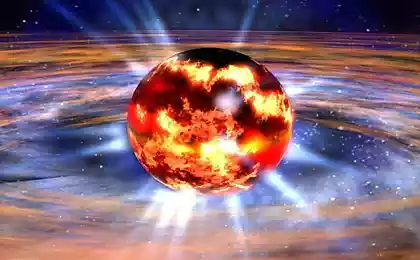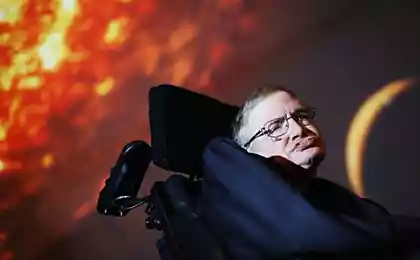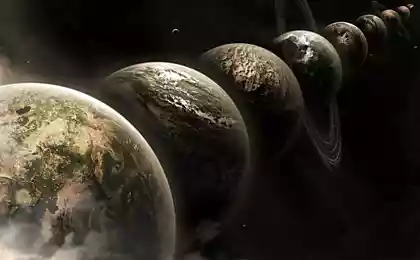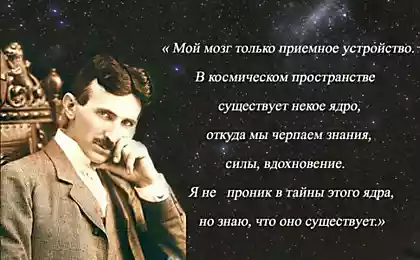579
Scientists have proved that the universe is expanding, with a red light
Less than a hundred years ago, astronomers are still discussing whether the Milky Way across Vselennoy
In 1920 Edwin Hubble was two things, allowed him revolutionize the way people saw the universe. One thing was the largest at the time the telescope in the world, and the other - an interesting finding his fellow astronomer Vesto Slipher, who saw in the nebula - what we now call galaxies - and was intrigued by their glow, the former is much redder than it was possible suggests. He tied it with a red shift.

Imagine that you and another man standing near a long rope, and every second it pulls you. At this time, there is a wave of the rope, giving the other person know that the rope jerked. If you briskly walked away from the man, the distance that you cover, wave per second would have to overcome, and, from the point of view of the other, the rope will have to twitch every 1, 1 second. The faster you go, the longer it will take for the other person between spurts.
The same thing happens with light waves: the farther from the source of emission is the observer, the less are the peaks of waves, and it moves to the red part of the light spectrum. Slipher concluded that the nebula appear red because moving away from the Earth.
Hubble also took a new telescope and began to look for the red shift. He found it everywhere, but some stars seem to some extent "redder" than others, some stars and galaxies only slightly shifted towards red, but sometimes redshift is maximized. After collecting a lot of data, built the Hubble diagram showing that the redshift of an object depends on its distance from the Earth.
Thus, in the XX-th century it was proved that the universe is expanding. Most scientists looking at the data suggested that the expansion is slowing. Some believed that the universe will be gradually expanded to a certain limit, which is, but she nonetheless never reach, while others thought that this limit is reached the universe will begin to contract. However, astronomers have found a way to solve the problem: for this they needed the latest telescopes and a little help from the universe in the form of a Type 1A supernova.

As we know, the brightness varies depending on the distance, you know, and how far away are these supernovae and how many years of traveling light, before we could see it. And when we look at the redshift of light, we know how the universe expanded during this time.
When astronomers look at distant and ancient stars, they noticed that the distance does not match the degree of enlargement. The light from the stars walked us longer than expected, as if the expansion was slower in the past - so it was found that the expansion of the universe is accelerating, rather than slowing down.
via factroom.ru

In 1920 Edwin Hubble was two things, allowed him revolutionize the way people saw the universe. One thing was the largest at the time the telescope in the world, and the other - an interesting finding his fellow astronomer Vesto Slipher, who saw in the nebula - what we now call galaxies - and was intrigued by their glow, the former is much redder than it was possible suggests. He tied it with a red shift.

Imagine that you and another man standing near a long rope, and every second it pulls you. At this time, there is a wave of the rope, giving the other person know that the rope jerked. If you briskly walked away from the man, the distance that you cover, wave per second would have to overcome, and, from the point of view of the other, the rope will have to twitch every 1, 1 second. The faster you go, the longer it will take for the other person between spurts.
The same thing happens with light waves: the farther from the source of emission is the observer, the less are the peaks of waves, and it moves to the red part of the light spectrum. Slipher concluded that the nebula appear red because moving away from the Earth.
Hubble also took a new telescope and began to look for the red shift. He found it everywhere, but some stars seem to some extent "redder" than others, some stars and galaxies only slightly shifted towards red, but sometimes redshift is maximized. After collecting a lot of data, built the Hubble diagram showing that the redshift of an object depends on its distance from the Earth.
Thus, in the XX-th century it was proved that the universe is expanding. Most scientists looking at the data suggested that the expansion is slowing. Some believed that the universe will be gradually expanded to a certain limit, which is, but she nonetheless never reach, while others thought that this limit is reached the universe will begin to contract. However, astronomers have found a way to solve the problem: for this they needed the latest telescopes and a little help from the universe in the form of a Type 1A supernova.

As we know, the brightness varies depending on the distance, you know, and how far away are these supernovae and how many years of traveling light, before we could see it. And when we look at the redshift of light, we know how the universe expanded during this time.
When astronomers look at distant and ancient stars, they noticed that the distance does not match the degree of enlargement. The light from the stars walked us longer than expected, as if the expansion was slower in the past - so it was found that the expansion of the universe is accelerating, rather than slowing down.
via factroom.ru
In the 18th century in France in the day it had 10 hours instead of 24
You can become the owner of the whole island for just $ 500,000
























